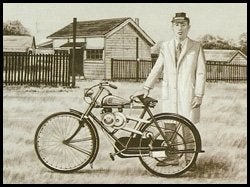 A HUMBLE START
A HUMBLE STARTStarting production with a single bike, which was nothing more than a motor stuffed in a bicycle frame, Honda went on to become the world leader.
If the name Honda doesn't ring a bell with you, chances are you spent the last 20 years or so working in a cave sorting mushrooms for a living. The real Honda story, the one that's meaningful to us dirt bike freaks, started here in the United States in 1959. That's when Soichiro Honda opened up a tiny shop in Los Angeles. His model line consisted of a number of street bikes with fenders that looked like pelican beaks.
At the time his reception was anything but wonderful. His hard-working salespeople were discouraged as they went around the country trying to establish dealerships. People were riding Triumphs, BSAs, Harleys and a wide assortment of British singles.
The bike riders of that period were considered lunatic-fringe outcasts. Bikers were divided into three basic groups: (1) crazed outlaws; (2) racers; (3) a small handful of people who actually used bikes for transportation and touring. There was no such thing as trail riding. Why? Because there were no such things as trail bikes.
 All bikes sold were street bikes; some lent themselves to being stripped for racing and others were naturals for being made into choppers. There were a few oddball small bikes and scooters, like Cushmans and Mustangs, but the bulk of the bikes sold here were big singles and four-stroke twins.
All bikes sold were street bikes; some lent themselves to being stripped for racing and others were naturals for being made into choppers. There were a few oddball small bikes and scooters, like Cushmans and Mustangs, but the bulk of the bikes sold here were big singles and four-stroke twins.
YOU MEET THE NICEST PEOPLE ON A WHAT?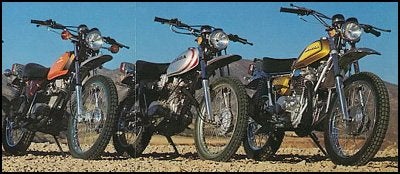 So here's Mr. Honda, with a lineup of small-displacement bikes to sell, and nobody wanted them. How bad was it?
So here's Mr. Honda, with a lineup of small-displacement bikes to sell, and nobody wanted them. How bad was it?
At the end of 1959, Honda had sold about 1,700 units and had only 15 dealers. The books showed a cash loss of $54,000. At that point, no one would have dreamed that this small company would become the dominant force in American motorcycling. Things were different in Japan, though. That same year they were struggling like door-to-door sushi salesmen in the U.S., they became the number-one motorcycle manufacturer in the world, with unit sales of 500,000.
Many of Mr. Honda's advisors told him to write off the American market and concentrate on Europe, where they appreciated small, reliable, economical and inexpensive bikes. The combined sales of all motorcycle brands in the U.S. were a mere 60,000 units a year, and the image of bikers was a few steps below ugly.
Honda was starting to win road races in Europe, sales were going up everywhere, and more and more models were being introduced, but the American market remained stagnant. This brought about one of the most famous advertising campaigns of all time. The phrase “You meet the nicest people on a Honda!” became a byword, as Honda saturated the market with advertising.
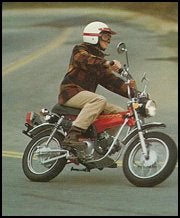 The ads showed smiling ladies on cute little bikes with businessmen wearing suits, riding around with insane grins on their faces. The image of the greasy-haired thug with unwashed Levis was effectively being erased. People started to think in two different directions: there were motorcycles (ugh!) and then there were the cute little Hondas that all the swell folks rode around.
The ads showed smiling ladies on cute little bikes with businessmen wearing suits, riding around with insane grins on their faces. The image of the greasy-haired thug with unwashed Levis was effectively being erased. People started to think in two different directions: there were motorcycles (ugh!) and then there were the cute little Hondas that all the swell folks rode around.
Ah yes, the bikes. Face it, those early Hondas were the elevator music of motorcycling. They were slow, funny-looking and boring to ride. But they were also dead-on reliable. Hondas did not drip oil on your garage floor, they didn't fling oil on your pants, the electrical systems were marvels of reliability and the fit and finish were worlds superior to every other motorcycle on the market.
You didn't have to be a mechanical whiz to ride a Honda; all you had to do was know where to put the gas. Check the oil? Naw! Just ride the sucker. And if you parked it behind the Buick for a month or so, it would still start easily and sit there idling like a field mouse snoring.
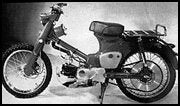 They were cheap, got great mileage and never broke. Even the dealer network was different. Honda shops did not have Sacramento Mile posters on the walls. They were not dark, dank places with leaking cans of Castrol on the shelves. Instead, they were bright, cheerful places with a lineup of brightly colored little bikes on display.
They were cheap, got great mileage and never broke. Even the dealer network was different. Honda shops did not have Sacramento Mile posters on the walls. They were not dark, dank places with leaking cans of Castrol on the shelves. Instead, they were bright, cheerful places with a lineup of brightly colored little bikes on display.
Want a test ride, sir?
No problem.
Try the same thing at a Harley or a Triumph shop and they'd fling you out the door in front of a passing bus.
IMMEDIATE RESPONSE
The big push clearly worked. By 1963, Honda's U.S. sales were up to 150,000 units. Things were on a roll. In 1961, some genuinely nifty bikes appeared, with the racy names of Hawk and Scrambler.
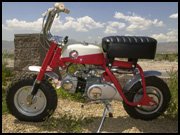 Small Hondas started appearing on the bumper racks of campers and motor homes. Retired folks, who would never consider themselves bikers, were buying Trail 50s and Super Cubs by the carloads. They used these street-legal bumblebees to flit around campgrounds and to wander out to their favorite fishing spots.
Small Hondas started appearing on the bumper racks of campers and motor homes. Retired folks, who would never consider themselves bikers, were buying Trail 50s and Super Cubs by the carloads. They used these street-legal bumblebees to flit around campgrounds and to wander out to their favorite fishing spots.
Trail riding in the United States was born, and these little bikes let it happen!
The rest is history. Honda continued to bring out more and better models, then real true dirt bikes. By the time the dirt bike boom started (1968), Hondas were everywhere! They were being raced in the desert, trail-ridden all across the country, hammered in enduros and hyper-tuned for TT tracks and scrambles.
During this period of rampant growth, certain Honda models were landmarks ... very important bikes that were breakthroughs. To keep things even, Honda also produced some real losers. So let's take a look in the past (completely ignoring the street bikes and ATVs, simply because they bore me) and have some fun.
FABULOUS 50s!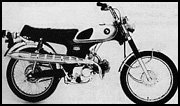 In 1961, the CA 100T (Trail Cub) appeared in school parking lots, retirement villages and on the backs of motor homes in droves. The tiny 50cc four-stroke engine was mated to a three-speed with an automatic clutch. It looked like a pair of pipe bombs glued together with the engine hanging down low like an afterthought.
In 1961, the CA 100T (Trail Cub) appeared in school parking lots, retirement villages and on the backs of motor homes in droves. The tiny 50cc four-stroke engine was mated to a three-speed with an automatic clutch. It looked like a pair of pipe bombs glued together with the engine hanging down low like an afterthought.
The step-through frame let ladies with skirts ride it without getting arrested, and acceleration and top speed just about guaranteed no tickets.
During that same time, there was also a C110 Super Sports Cub that looked more like a real motorcycle, even though it shared most of the power train of the Trail 50. It had a high pipe and a gas tank in the normal location. The manual clutch definitely gave it a more sporting nature, but still most any kid on a Schwinn could out-accelerate it. The first real minibike from Honda made exclusively for the dirt was the Z50 Mini-Trail in 1968. Looking much like a deformed bug, the three-speed unit had fold-up handlebars so the bike could be easily stuffed in the trunk of a car.
With a total sale of 450,000 units, the Z50 still holds the record as American Honda's all-time best-selling bike, and it is responsible for introducing off-roading to more youngsters than any other single model.
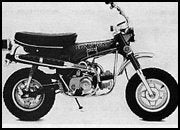 After a dozen years of virtually unchanged 50cc trail bikes, in 1974 Honda brought out a stunning package, the MR 50 Elsinore. It had real knobbies, a three-speed gearbox, looked every inch like a miniature race bike and, wonder of wonders, it was a two-stroke. A whole bunch of happy kids learned how to trail ride on this tiny beauty.
After a dozen years of virtually unchanged 50cc trail bikes, in 1974 Honda brought out a stunning package, the MR 50 Elsinore. It had real knobbies, a three-speed gearbox, looked every inch like a miniature race bike and, wonder of wonders, it was a two-stroke. A whole bunch of happy kids learned how to trail ride on this tiny beauty.
SMALL STUFF: 60cc to 90cc
In the late 60s, kids all over American smuggled bike magazines into study hall and salivated over the ads for the Honda Scramblers. The CL90 (from 1967 to 1969) and the CL70 (from 1969 to 1973) housed overhead cam four-stroke singles with four-speed gearboxes. Any kid lucky enough to have one was “Big Man on Campus.”
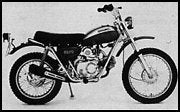 Another innocuous trail bike became available in 1969. The CT70, known popularly as the Trail 70, was yet another unbreakable fat-tired machine. Powered by a 72cc four-stroke with a three-speed auto clutch (or four-speed manual clutch), this high-piped unit was a favorite of hunters and fishermen, as well as fortunate kids.
Another innocuous trail bike became available in 1969. The CT70, known popularly as the Trail 70, was yet another unbreakable fat-tired machine. Powered by a 72cc four-stroke with a three-speed auto clutch (or four-speed manual clutch), this high-piped unit was a favorite of hunters and fishermen, as well as fortunate kids.
Although the CT70 remained basically unchanged from 1969 to its last year in 1982, it ranks as Honda's third best selling model with over 380,000 units sold. A fabulous small play bike was introduced in 1971, called the SL70 Motosport. It was a genuine small motorcycle, with a tube frame and all the right stuff, including a four-speed gearbox. Numerous versions of this jewel were made through 1976, although it took on the XL designation in 1974.
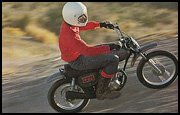 The most popular bike of the mid-70s was the famed XR75 mini-bike. While it has some flaws, like the footpeg mounts, it was largely a bullet-proof bike that would survive the thrashing of the most ham-fisted kid. Doting fathers spent small fortunes turning the reliable XRs into unreliable high-revving machines. It was not uncommon to see and extra two grand or more sunk into hop-up parts. By 1979, the XR75 grew into the XR80.
The most popular bike of the mid-70s was the famed XR75 mini-bike. While it has some flaws, like the footpeg mounts, it was largely a bullet-proof bike that would survive the thrashing of the most ham-fisted kid. Doting fathers spent small fortunes turning the reliable XRs into unreliable high-revving machines. It was not uncommon to see and extra two grand or more sunk into hop-up parts. By 1979, the XR75 grew into the XR80.
From 1964 through 1986, Honda produced an almost endless line of Trail 90s, all with the prefix, CT. All of them had frames that wiggled like fishing worms and the limpest chrome shocks ever seen this side of a cheap screen door. For over 20 years, very little changed on the CT, except for a displacement increase to 110cc in 1980.
HAPPY 100s?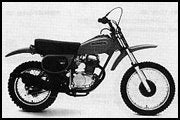 Following through on a theme of natural progression. Honda built larger versions of all the small bikes. A staggering variety of 100cc dirt bikes (yes, and street bikes) started in 1970 and continue today. Honda figured out early in the game how to capture customers at the introductory levels and it paid off.
Following through on a theme of natural progression. Honda built larger versions of all the small bikes. A staggering variety of 100cc dirt bikes (yes, and street bikes) started in 1970 and continue today. Honda figured out early in the game how to capture customers at the introductory levels and it paid off.
Of the bewildering number of models, a few stand out and a few more are confusing as to why they existed at all. Example: in 1970 they made a CL100 Scrambler and an SL100 Motosport. The Scrambler had a high pipe and low fenders, while the Motosport had high fenders and a low pipe. You figure it out.
The delightful XR100 debuted in 1981. We don’t know of any other bike bought for girlfriends and wives. The 100 was large enough to allow a full-sized person to ride it comfortably, yet mellow enough for a beginner to learn on.
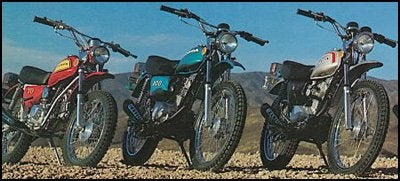 In 1980 a real racing minibike was brought out to head-to-head with the YZ80: the CR80R Elsinore. Blood-red, the mini-Elsinore had a six-speed box and a punchy two-stroke engine.
In 1980 a real racing minibike was brought out to head-to-head with the YZ80: the CR80R Elsinore. Blood-red, the mini-Elsinore had a six-speed box and a punchy two-stroke engine.
The 1983 and 1984 model years saw a genuine 60cc mini racer that looked just like the big bikes. Named the CR60R, this astonishing bike featured a six-speed gearbox and had plenty of beans. It was not for the beginner and a number of learning riders got some wide eyes and unexpected wheelies on the CR.
125s TO GO!
Probably no single article in the magazine business generated as much hate mail as did my test report on the 1973 SL125. The title to the story said it all: The SL125 Turtle Chase - Honda's Inoffensive Little FooFoo Bike.
The first paragraph of the test no doubt had readers scrambling for a pen and paper to tell us off. It read: “Yup, the 125 Honda is the pokiest bike we have tested to date. It's probably the slowest full-sized dirt bike in existence. Word has it that even the SL100 will blow its doors off.”
The test report was even more caustic: “If you put a wrench on the engine twice a year, it will last forever and ever. One reason for this is because it's gutless. As a rule, the more horsepower the engine develops, the higher the wear factor. Since the SL125 develops no power, there is no wear. Clever, those Honda fellers.”
It got worse as we ragged on the bike: “We asked American Honda what the factory claims in the way of horsepower. ‘Honda doesn't claim any horsepower,' was the reply. We found that alarmingly accurate.”
THE TRIALS FIASCO
Someone told all of the Japanese manufacturers that trials was the hot ticket in 1973, so Honda brought out a TL125 Trials bike. It sold like stale bread. But then, so did all of the other trials bikes from Japan.
THE SHOCKER!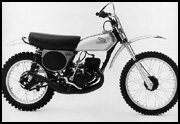 After a mind-numbing series of hopelessly dull street and Scrambler (?) 125s, Honda made up for it all with a staggeringly good bike, the 1973 CR125M Elsinore. Everybody raved about it: Testing Honda’s 20-Horsepower Feather! screamed the cover lines.
After a mind-numbing series of hopelessly dull street and Scrambler (?) 125s, Honda made up for it all with a staggeringly good bike, the 1973 CR125M Elsinore. Everybody raved about it: Testing Honda’s 20-Horsepower Feather! screamed the cover lines.
The baby Elsinore sold for $749 and I had this to say about the bike: “We suspect it'll be around 1000 bucks . . . even if it were 1200 bucks, it would be the bike to buy. And the reason is simple: it is the best 125 you can buy, regardless of price.” This was back when only the most exotic 125s were in the one thousand dollar range.
For its day, the specs were awesome: 7.1 inches of fork travel and 4.1 at the rear, 19.7 hp@8000 rpm, 188 pounds with a half-tank of gas, a six-speed close-ratio gearbox and brakes that actually worked.
Only a few flaws were evident: the swing-arm pivots were junk plastic and had to be replaced with bronze bushings, the shocks faded in 20 minutes and the gearbox lost second gear every now and then. But other than those, it did everything in a brilliant fashion.
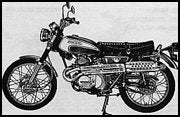 My quote in the last paragraph of that test was strong enough to get us in big trouble with other manufacturers: “Honda is left with only one problem: How are they going to make enough of them? The rest of the manufacturers are left with another problem: What can they do to justify the existence of their offerings?”
My quote in the last paragraph of that test was strong enough to get us in big trouble with other manufacturers: “Honda is left with only one problem: How are they going to make enough of them? The rest of the manufacturers are left with another problem: What can they do to justify the existence of their offerings?”
In 1974, Honda built a semi-sort of an enduro bike, the MT125 Elsinore. It looked right, the specs read right and, on paper, would make a great enduro bike. Unfortunately, it was not much faster than a melting iceberg and was discontinued after two more years. No one missed it.
For 1981, the 125 Elsinore got water cooling. It also got slower, heavier and single-shocked. For half of the season, the 1980 bikes outran it.
The 125 Elsinore evolved slowly until 1982, when the legendary Elsinore name was dropped and the bikes simply became known as CRs. In 1984, another highlight in the CR line was introduced. This 125 had KYB forks and shocks, unlike the Showa units normally used by Honda.
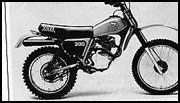 It's no secret that the reason Honda uses Showa forks and shocks is because they own controlling interest in that company. It's also no secret that Showa never made a truly great shock, up to this very day. We have no idea why they used the KYB suspenders for this one year only, but they worked … and the bike worked!
It's no secret that the reason Honda uses Showa forks and shocks is because they own controlling interest in that company. It's also no secret that Showa never made a truly great shock, up to this very day. We have no idea why they used the KYB suspenders for this one year only, but they worked … and the bike worked!
A few of the early 125s came through with a faulty ATAC system, but most of them were delivered with the right setup and nothing could stay with them in 1984. In 1985, it was back to Showa and shock woes.
The 1987 CR125: wow! Disc brakes at both ends, case induction, cartridge forks, a blistering motor, scalpel-sharp turning and styling that was a decade ahead of everything else. Sure it shook and shuddered at high speeds over bumps, but remember, this powerhouse was built for MX.
The 88 and 89 CR125 undoubtedly had the best 125cc mill ever offered to the public up to that time, and became a standard.
BEYOND THE SMALL STUFF
After the almost bewildering offering of small bore machines, let's take a look the larger offerings, from 160 to 600cc, starting with the 160-200cc machines.
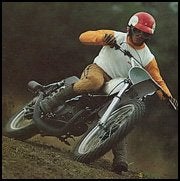 In 1966, Honda built a tight, decent bike called the CL160 Scrambler. A number of them received light modifications and were competitive in the 200 Class in enduro and scrambles work. This high-piped unit was as close to unbreakable as any bike ever made. By 1969 Honda sensed the demand for a larger, more refined machine and released the CLI75. Honda responded to the surge in off-road riding with a high-fendered CL175 in the same year.
In 1966, Honda built a tight, decent bike called the CL160 Scrambler. A number of them received light modifications and were competitive in the 200 Class in enduro and scrambles work. This high-piped unit was as close to unbreakable as any bike ever made. By 1969 Honda sensed the demand for a larger, more refined machine and released the CLI75. Honda responded to the surge in off-road riding with a high-fendered CL175 in the same year.
Dirt bikers wanted an even more off-road-worthy mount in this size class and Honda gave them the SL175 in 1970. It used the strong, high-revving CL175 twin and had contemporary dirt bike styling for the period.
The Honda stepped on their corporate pecker with the XL175 in 1973. It was a real pile, leading me to run a photo of a large white pig right next to the bike in a pigpen. The subtitle of the test, in rather large type, said, AT $2.98 A POUND, THIS IS EXPENSIVE PORK.
Still, a lot of folks loved the XL175. I hated it. Not only was it hopelessly slow, it was also the only four-stroke we ever tested that fouled plugs regularly. The regular testers were unable to climb even moderate hills. Some say that we got the legendary lemon, but we rode others and remained in the full yawn mode.
In 1975, the MRI75 was released. A promising looking machine, the MR was based on the immensely successful CR125. It lacked the thrust of the CR and its six-speed gearbox. As a result, it made a better play bike than an enduro racer.
The 1979 XL185S proved to be a surprisingly good trail bike, in spite of being laden with a dash like a jukebox. Many a rider stripped it down, put on knobby tires and ended up with a great street-legal trail bike.
Another highlight appeared in 1980. The XR200 turned out to work well in the woods and for all-around trail riding. It was a six-speed four-stroke single with no bad manners and a deceptively good powerband. By slapping on a set of decent shocks and good tires, a number of B riders won enduros. For decades, the XR200 remained a solid trail bike
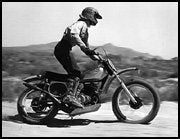 THE MIDDLEWEIGHT CLASS - 250cc
THE MIDDLEWEIGHT CLASS - 250cc
From 1959 through the mid-60s, most people thought of Hondas as models with butt-ugly fenders and styling with names like Dream. The styling was, indeed, a nightmare, a variation of a dream.
The first 250 offered by Honda was the 1961 CL72 Scrambler, or its more street-oriented brother, the CB72 Hawk. The Scrambler became the recipient of knobbies, wider bars, Snuff-Or-Not exhaust tips (little flappers placed in the end of straight pipes that could be opened for racing and closed for quiet street use), and getting a stripdown for racing use.
This 247cc, four-speed, OHC, dual-carbed engine cranked out lots of good power and, even better, emitted a throaty rasp when you revved it high. I raced one in an enduro in Ohio, and did pretty well until I hit a log and stuffed my head into the mud. Back then, we didn't realize that skinny chromed shocks and wimpy forks affected handling.
There were a handful of truly remarkable bikes in the last 40 years, and one of the landmark machines has to be the 1972 XL250 Motorport. This four-valve single used a single overhead cam to operate its valves. It made respectable power, but overall performance was marred by serious heft. Nonetheless, the machine's dependability and quietness gave it a mass cult following among woodsmen and trail riders. The XL250, in it's many forms, continued so be sold for many years.
IT CHANGED MOTOCROSS FOREVER! 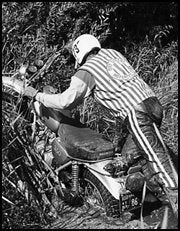 A milestone happened in 1973, when the Honda CR250M Elsinore was released to the public. And the public went wacko! This bike was pure, unadulterated dynamite!
A milestone happened in 1973, when the Honda CR250M Elsinore was released to the public. And the public went wacko! This bike was pure, unadulterated dynamite!
How good was it? Well, in mid-1973, I sold my 501 Maico and went out and bought a brand-new 250 Elsinore. Almost immediately, I started actually winning motocross races in the 250 Junior class. Amazing!
This sleek, lightweight beauty had a polished aluminum tank, a raspy motor with bags of midrange punch, a slim midsection and styling that had the riders of that era gasping and reeling in circles. Not only that, the forks worked better than anything Japan had ever offered and the shocks were good for about 20 minute – until they got hot. It weighed in at a wafting light 214 pounds and had 7.1 inches of travel up front, which was state-of-the-art at that time in ancient dirt biking history. The dyno showed that the Elsinore pulled a staggering rear wheel 28 horsepower, about three more than anything else short of a flat-out TT bike.
How good was the 250 Elsinore? It was best answered when a Honda rep, George Ethridge, was asked: George, are you guys trying to put everyone else out of business?
Nope, he replied, we're just trying to make them get a whole lot better.
Stay tuned for Part 2 of the Honda history next month.


 Your Privacy Choices
Your Privacy Choices